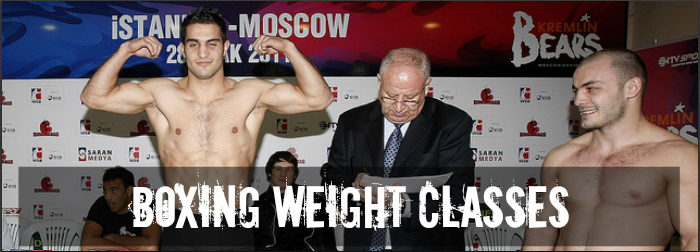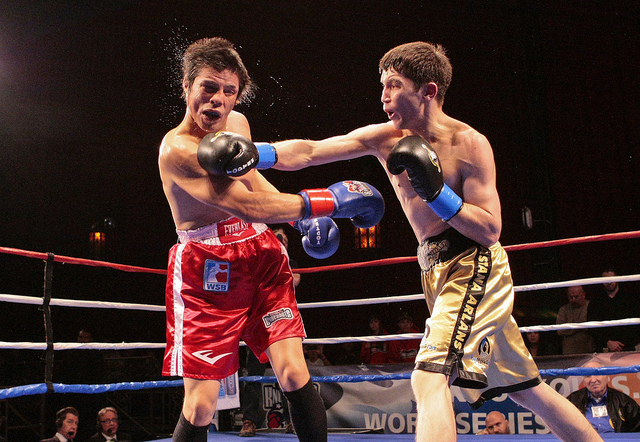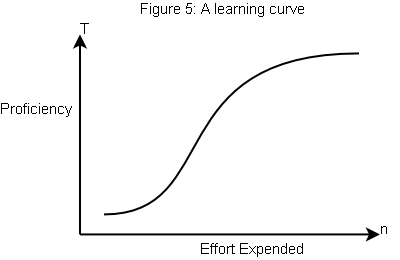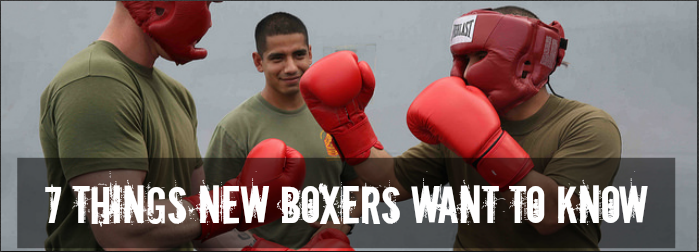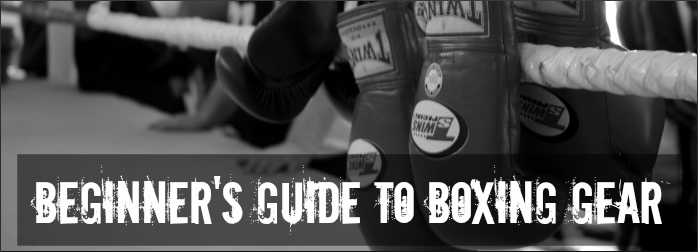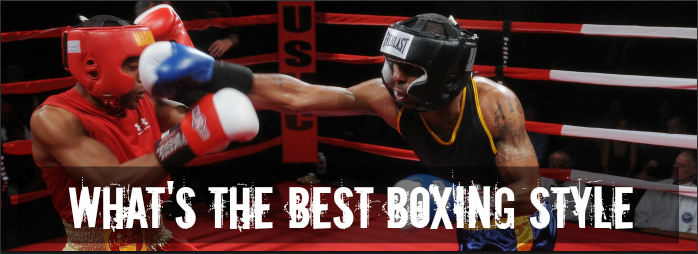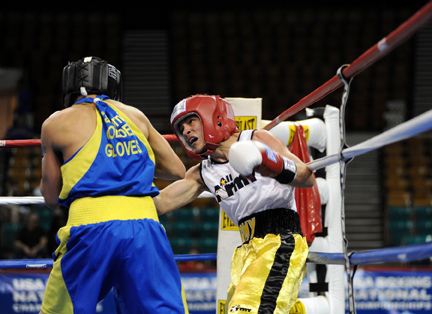We all want to know how to punch harder.
For a boxer, there is nothing more satisfying than knocking out your opponent - landing the perfect punch that sends him sprawling across the canvas - dropping him instantly as his legs buckle and his body goes limp as he's instantly transported to the land of dreams.
Some boxers are born with a natural ability to punch while others have to work at it, but the good news is that you can learn to punch harder. And, if you're a slow learner, you'll be happy to know that it doesn't take a lot of power to knock someone out.
I remember the first (and so far only) time I almost got knocked out. I dropped my right and I got a hard left hook to the head. I felt something like an electric shock shoot down through my body causing my legs to instantly relax as if I was paralyzed. I caught myself before I hit the canvas and regained enough control to keep going, but I'll never forget that feeling.
You'll also be happy to know that punching straight out from the chin like a boxer is not a natural thing to do so anyone coming into the sport has at least some of the same hurdles that you do. Hitting straight and fast from the shoulder with the full weight of your body behind it takes years of study and practice to perfect.
THE SCIENCE BEHIND PUNCHING POWER
Punching power is measured in Newtons (N) or pounds of force (in the US). Consider the results of this study that calculated punching force of 10 Olympic boxers across four weight classes (flyweight, light welterweight, middleweight, and super heavyweight). In the final analysis, glancing blows were not considered which brought the result set down to 18 punches across 5 boxers. I've further excluded one super heavyweight boxer from the data below to maintain similarity between weight classes:
Punch Force of Four Weight Classes
| | | |
|---|
| | | |
light welterweight (139lb) | | | |
| | | |
super heavyweight (240lb) | | | |
Hand Speed of Four Weight Classes
| | | |
|---|
| | | |
light welterweight (139lb) | | | |
| | | |
super heavyweight (240lb) | | | |
The study found:
- Punch force increases linearly with weight class.
- Hand velocity does not correlate to weight of boxer, peak force, or severity of punch.
- Effective mass of a punch is most important in determining the punch force and resulting severity of the punch.
Interestingly, three of the four boxers had what we would consider good technique and maintained a rigid wrist throughout the punch (flyweight, light welterweight, and super heavyweight). In all three cases the effective mass of their punch equated to the approximate weight of their arm. The middleweight flexed his wrist on impact which diminished force applied and resulted in an effective mass equal to the approximate weight of his hand.
The physics involved can get complex. Effective mass is based on the law of conservation of momentum - p=mv where p is momentum, m is mass and v is velocity. Thus, increasing either mass or velocity increases momentum. In relation to force, F=ma where m is mass and a is acceleration, thus increasing either mass or acceleration increases force. Other physics involved include the effects of collision, rotational acceleration, and kinetic energy.
I'm going to stop trying to explain this now before your eyes glaze over - but if that stuff interests you - fill your boots.
WHAT DOES THIS TELL US ABOUT DEVELOPING PUNCHING POWER?
Well, the data seems to reinforce what boxing coaches have intuitively known all along:
- Punching power increases by weight class - heavyweights hit harder than flyweights.
- Flyweights are faster - they have quicker hand velocity.
- Technique is paramount in developing powerful punches.
To some extent it reinforces the notion that punching power is a natural ability - you are born with it - as you are genetically determined to reach a certain natural weight. We can all move up and down within our genetic limits, but if we don't consciously decide to lose or gain weight, we'll end up at some predetermined weight over time.
It is also obvious that one can increase punching power by maximizing the effective mass of his or her punch through proper technique.
When I looked at this data it was interesting to me that speed wasn't playing more of a factor in how much force is generated. I also found it odd that the middleweight had faster average hand velocity (11.9m/s) than all the other weight classes who generally averaged in the 7.5-9.2 m/s range.
It then occurred to me that the study is looking at elite level boxers. One can be reasonably sure that those boxers have developed their body's muscularity and coordination to the point where they are able to most efficiently move the mass of their arms at the highest possible speed.
The middleweight, on the other hand, was flexing his wrist. This improper technique explains how he is so much faster than the other classes as he wasn't moving as much mass - effectivley only his hand versus his entire arm. I'm sure that middleweight is a great boxer and is obviously blindingly fast and will score points - but he isn't doing the same amount of damage to his opponents that the other classes are.
From the novice's perspective - speed will play a factor in generating punching power up to the point where your body has reached its peak potential to move the mass involved - your arm. From there, punching power becomes more a function of technique and maintaining that maximum velocity as you increase arm mass.
HOW TO INCREASE PUNCHING POWER
Now that we understand what is involved - what can you do and in what order to increase your punching power keeping in mind the ultimate goal is to maximize effective mass at the moment of impact?
Perfect Punching Technique
Forget about punching hard in the beginning. The best thing you can do to learn to hit harder the fastest is to ensure every aspect of your punch is absolutely perfect.
That means your stance is perfect, your pivot is perfect, your arm shoots straight out and rotates perfectly, and your wrist is perfectly rigid at impact. The chain reaction that generates momentum beginning in your toes and exits your fist can have no kinks, bends or breaks.
The momentum generated in each stage has to be passed perfectly to the next without any loss to compound throughout the entire lifecycle of the punch to peak milliseconds before impact.
If you think of your body as a machine made of a bunch of parts that produces punching power - you want to make sure that all parts of that machine fit together perfectly.
Maximize Conditioning
Once the machine is built properly, then you can increase punching power by maximizing how much work each part in the machine is doing.
Each part is a muscle and each muscle has the potential of generating a maximum amount of force. To maximize punching power every part has to work at its maximum. You can have no weak points.
Every muscle has to be able to accept the momentum generated by the muscle before it and pass it along with its output to the next muscle in the chain - accelerating the momentum along the way to impact.
So, by training to ensure every single muscle involved is developed to the point where it is 100% efficient and producing as much power as possible - coupled with a perfect technique - you'll be able to propel your arm at maximum velocity towards your target.
Assuming you've achieve perfection and optimal output in each stage - you'll be hitting with maximum effective mass.
Increase Effective Mass
Going back to our machine example, if the machine is running at peak efficiency, the only way to increase production is to increase the capacity of the machine - make it bigger.
After technique is perfect and your current muscles are trained as they are going to get - you increase muscle size being careful not to go outside your weight limit for the class you compete in. You have to do this slowly and deliberately to prevent any added mass from messing with your perfect technique. In whatever weight class you are in - you should always strive to reach your ideal weight.
You have to be smart about this though. Screwing up the punch bio mechanics you've perfected to this point as you compensate trying to move a heavier arm makes little sense. You might like having bigger arms - but they aren't going to help you punch any harder if your technique suffers.
You can increase effective mass by increasing the mass of your arms, but if you do, every muscle in the chain before that has to evolve to be able to move that added mass in your arm. If you can do that and still stay in your weight class - you're golden. If you can't, then adding additional muscle may not be the best option.
The Limits
You will reach an upper limit of the amount of punching power you can generate. Like any sport or skill, you'll go through the stages of the learning curve. You'll start out slowly as you learn some of the basics. You'll experience a quick surge of progress and see massive gains in punching power that over time will diminish. As your level of skill increases, it will continually be more difficult to get an extra Newton or pound of force in your punch. That's an indication that your reaching your optimal level of punching power. At some point the effort required to generate an ounce more of power may not be worth the time and effort required.
TRAINING TO INCREASE PUNCHING POWER
As a coach, in addition to strength and conditioning training focused on strengthening the core, calves, quads, shoulders and triceps of my boxers, I'd focus most of my effort on perfecting the following aspects of the boxer's punch delivery:
Perfect the waist pivot - Momentum transfers from the lower body through the pivot that occurs at the waist. It is not a swinging movement, but rather purely rotational as the shoulders are moved towards the center line of the body. In an orthodox boxer, the left side of the body, down through the forward leg is the pivot point. As long as the line isn't broken, maximum power can be generated.
IN SUMMARY
Remember:
- punching power is a result of hitting with the body, not just the arms
- the arms are simply the projectiles that transfer the force to your opponent
- you increase power by generating momentum from the bottom up using perfect technique and conditioning
- pivoting is the key component that takes the momentum generated from the lower body, accelerates it, and transfers it to the arm
- maintaining a rigid wrist and rotating the arm correctly puts the full weight of your body behind the punch (maximum effective mass)
- punching power is a combination of natural ability and learned technique



















